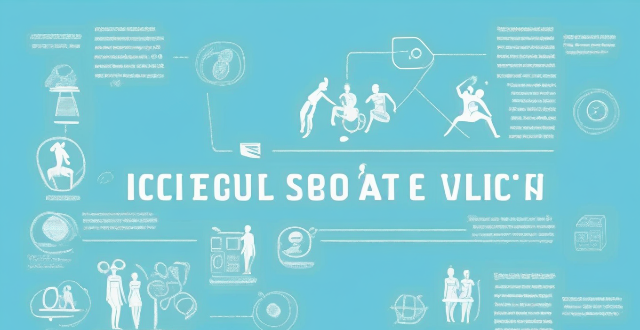Sports Equality

How has sports contributed to gender equality ?
Sports have contributed to gender equality by increasing participation, equal pay, media coverage, and female leadership in sports administration.

How does gender equality affect participation in competitive sports ?
Gender equality is a fundamental human right that ensures individuals are not discriminated against based on their sex. In the realm of competitive sports, gender equality can significantly influence participation rates, access to resources, and overall opportunities for athletes. This discussion will explore how gender equality affects participation in competitive sports. The importance of gender equality in sports includes equal opportunities, media coverage and representation, financial support and sponsorship, and safety and well-being. Challenges faced due to lack of gender equality include unequal participation rates, limited career opportunities, and cultural barriers. Strategies to promote gender equality in sports include policy changes, education and awareness, and supportive infrastructure development. In conclusion, gender equality plays a crucial role in determining participation rates in competitive sports. By addressing issues such as unequal opportunities, media representation, financial support, safety concerns, and cultural barriers, we can create a more inclusive environment that encourages females to engage actively in sports. Through policy changes, educational initiatives, and supportive infrastructure development, we can promote gender equality within the world of competitive sports, ensuring that talent and passion are the only determining factors for success.

In what ways can we promote gender equality in sports for young children ?
Gender equality in sports is crucial for fairness and respect, especially among young children. To promote this, mixed-gender teams should be encouraged, equal opportunities provided, non-binary athletes supported, coaches and parents educated about gender equality, diversity celebrated, gender bias addressed, and safe spaces created for all athletes.

To what extent does the globalization of sports contribute to social equality and inclusion ?
The globalization of sports has led to increased opportunities for athletes from different backgrounds and cultures, but also poses challenges to social equality and inclusion. Efforts are needed to address these challenges and promote fairness, inclusivity, and respect for all athletes.

How can we use sports to promote gender equality and empower women and girls ?
Promoting gender equality and empowering women and girls through sports involves increasing visibility, ensuring fair representation, improving access and inclusivity, providing education and training, implementing policy and legislation, promoting health and wellness, encouraging economic empowerment, engaging the community, and fostering cultural change. These efforts aim to break down barriers, challenge stereotypes, and create opportunities for women and girls to thrive both on and off the field.

What role do sports organizations play in promoting gender equality within their leagues or competitions ?
Sports organizations have a crucial role to play in promoting gender equality within their leagues or competitions. They can ensure that all athletes, regardless of their gender, have equal opportunities to participate and succeed in sports through various measures such as ensuring equal representation, providing equal pay and prize money, creating safe and inclusive environments, promoting female athletes as role models, and offering educational programs and workshops focused on gender equality in sports. By implementing these measures, sports organizations can create a culture of respect and inclusivity while ensuring that all athletes have equal opportunities to participate and succeed in sports.

Can sports be used as a tool for breaking down social barriers and promoting equality ?
The power of sports to bring people together and foster a sense of community is undeniable. However, the question remains: can sports be effectively utilized as a tool for breaking down social barriers and promoting equality? Sports organizations are increasingly recognizing the importance of diversity both on the field and off. By actively recruiting athletes from different backgrounds, sports can serve as a visible symbol of inclusion. Through exposure to diverse teams and athletes, sports can help dispel stereotypes and prejudices, encouraging fans and participants alike to appreciate the unique talents and contributions of individuals regardless of their background. Participation in sports teaches valuable life skills such as teamwork, discipline, and perseverance, which can be instrumental in overcoming social barriers. Success in sports can empower individuals, particularly women and minorities, by providing a platform for them to showcase their abilities and achieve recognition. Major sporting events can stimulate local economies by creating jobs and promoting tourism. Investments in sports facilities can revitalize neglected areas, providing much-needed resources and encouraging further development. Grassroots sports programs can engage community members, fostering a sense of belonging and pride that extends beyond the playing field. Unequal distribution of resources can hinder the ability of some communities to fully participate in sports. Physical accessibility for athletes with disabilities remains a crucial issue that needs to be addressed comprehensively. Ensuring equal opportunities and treatment for female athletes continues to be a focal point in the fight for equality in sports. Efforts to promote diversity must be genuine and avoid tokenism, ensuring that all participants feel valued and respected. Organizations must continuously assess their progress toward inclusivity and make necessary adjustments to maintain effectiveness. Educating stakeholders about the importance of inclusivity and equity is essential for maintaining momentum and driving change.

What is the role of sports sponsorship in promoting gender equality in sports ?
Sports sponsorship is crucial for promoting gender equality in sports. It provides financial support to female athletes, increases visibility of women's sports, creates role models, and promotes equity by ensuring equal funding for both men's and women's sports. This helps break down barriers and create opportunities for female athletes to compete at the highest levels.

What role does sports culture play in promoting gender equality ?
Sports culture has a significant impact on promoting gender equality by providing equal opportunities for participation, challenging stereotypes, and building inclusive communities. It empowers individuals through participation, leading to increased self-confidence and a sense of accomplishment. By recognizing and celebrating diverse representations of gender, sports culture can help to break down barriers and promote greater acceptance and respect for all individuals.

What policies or initiatives have been implemented to ensure equal pay and opportunities for both men and women in professional sports ?
In recent years, there has been a growing movement to ensure equal pay and opportunities for both men and women in professional sports. This has led to the implementation of various policies and initiatives aimed at achieving gender equality in sports, including gender equality laws and regulations, collective bargaining agreements (CBAs), wage transparency policies, gender quotas and targets, gender equality initiatives and programs, and improved media coverage and representation of women's sports. While progress has been made towards ensuring equal pay and opportunities for both men and women in professional sports, there is still much work to be done. By continuing to implement policies and initiatives that promote gender equality, sports organizations can create a more inclusive environment where all athletes can thrive regardless of their gender.

How have women's empowerment initiatives affected gender equality globally ?
The essay discusses the impact of women's empowerment initiatives on gender equality globally. The initiatives have increased access to education and training for women, leading to their active participation in public life. They have also provided economic empowerment through financial resources, microfinance loans, and entrepreneurship training programs, resulting in greater gender equality in the workplace. Health and reproductive rights have been improved through awareness campaigns and advocacy for policies supporting family planning and contraception. Finally, these initiatives have encouraged women's political participation, creating a more diverse and representative government. Overall, women's empowerment initiatives have played a crucial role in promoting gender equality worldwide.

What is the role of gender equality in achieving climate justice and sustainability ?
Gender equality is a key component in achieving climate justice and sustainability. It ensures equal opportunities for all individuals to participate in decision-making processes related to climate change mitigation and adaptation strategies, including access to education, healthcare, and economic resources. Gender equality recognizes the vulnerabilities of women and girls affected by climate change, promotes inclusivity, enhances resilience, drives innovation, and addresses intersectionality. Strategies for achieving gender equality in climate action include incorporating gender perspectives into policies, increasing representation, providing resources, encouraging collaboration, monitoring progress, educating stakeholders, advocating for legal protections, promoting cultural change, supporting research, and sharing best practices.

What role do international sports organizations play in fostering global cooperation ?
International sports organizations are crucial for global cooperation, promoting peace, cultural exchange, economic development, health, gender equality, environmental sustainability, and humanitarian aid.

What role do international sports organizations play in promoting peace through sport ?
International sports organizations contribute significantly to promoting peace through various initiatives. These include building bridges and enhancing diplomatic relations by promoting diplomacy and cultural exchange, providing platforms for youth development through empowerment and creating opportunities, advocating for gender equality and inclusivity, contributing to humanitarian efforts like disaster relief and peace missions, and educating about peace and conflict resolution through awareness campaigns and partnerships with peace organizations.

Can sports be used as a tool for conflict resolution and peacebuilding ?
The text discusses the potential of sports as a tool for conflict resolution and peacebuilding. It highlights the power of sports to break down barriers, promote equality, and build trust among individuals from different backgrounds, cultures, and beliefs. The text provides examples of how sports have been used in this context, such as the Olympics, Peace Teams International, and Soccer for Peace. It concludes that while sports alone cannot solve all conflicts or bring lasting peace, they can be a powerful tool in these efforts by creating a foundation for peace and understanding.

How do sports movies reflect societal attitudes towards health and fitness ?
Sports movies often reflect societal attitudes towards health and fitness, showcasing themes of motivation, teamwork, overcoming adversity, health awareness, and gender equality. These films can inspire viewers to push their limits, work together, persevere through challenges, prioritize their well-being, and support gender equality in sports.

How do gender stereotypes affect female adolescents' participation in sports ?
Gender stereotypes have a significant impact on female adolescents' participation in sports. These stereotypes can limit opportunities, discourage participation, and create barriers to success for young women in athletics. In this article, we will explore the ways in which gender stereotypes affect female adolescents' involvement in sports and discuss strategies for promoting gender equality in sports. One of the most significant ways that gender stereotypes affect female adolescents' participation in sports is by limiting their opportunities. Many schools and sports organizations still prioritize male athletes over female athletes, resulting in fewer resources and opportunities for girls to participate in sports. This can lead to a lack of access to quality coaching, training facilities, and equipment, as well as limited opportunities to compete at higher levels. Gender stereotypes also discourage female adolescents from participating in sports by perpetuating harmful beliefs about women's abilities and interests. These beliefs suggest that sports are not appropriate or desirable for girls, leading many young women to avoid athletic activities altogether. Additionally, some girls may feel pressured to conform to traditional gender roles, which often do not include participation in sports. Even when female adolescents do participate in sports, gender stereotypes can create barriers to their success. These barriers include discrimination, biased expectations, and unequal treatment compared to male athletes. For example, some coaches may have lower expectations for female athletes or provide less support and encouragement than they would for male athletes. Additionally, female athletes may face discrimination from opponents, officials, or even their own teammates. To combat the negative effects of gender stereotypes on female adolescents' participation in sports, it is essential to promote gender equality in athletics. Some strategies for achieving this goal include providing equal opportunities and resources for both male and female athletes; encouraging all students to participate in sports regardless of gender; educating coaches, parents, and peers about the benefits of sports for female adolescents; addressing discriminatory behavior and creating a culture of respect and inclusion within sports organizations; and celebrating the achievements of female athletes through media coverage and recognition events.

What are some examples of successful initiatives that use sports to promote social inclusion ?
This text discusses successful initiatives that use sports to promote social inclusion. It highlights five examples of such initiatives: Street Football World, Homeless World Cup, Wheelchair Basketball Initiatives, Sporting Equals, and Gender Equality in Sports Programs. These initiatives aim to unite people through football, inspire homeless people, promote disability inclusion, challenge discrimination in British Asian communities, and encourage women's participation in various sports, respectively. The activities include global tournaments for marginalized communities, international tournaments for homeless teams, local wheelchair basketball leagues, community cricket events, and women's sports leagues. The impact of these initiatives is significant, with increased public awareness about homelessness, personal transformation stories of participants, improved physical fitness and self-esteem among disabled individuals, reduced instances of racism and discrimination in sport, and higher visibility and recognition of women in sports.

How has the integration of sports and multiculturalism influenced global athletic events ?
The article discusses how sports and multiculturalism have influenced global athletic events, making them more diverse, inclusive, and engaging. It highlights the increased diversity and inclusivity, cultural exchange and celebration, promotion of gender equality, addressing social issues, and economic benefits for host countries. The article concludes by stating that these events continue to evolve and adapt to an increasingly interconnected world.

How can writers use sports as a metaphor for larger societal issues ?
The text provides a guide on how writers can use sports as a metaphor to explore larger societal issues. The playing field in sports is likened to a microcosm of society, where fairness, equality, and justice are examined. Teamwork and collaboration in sports are used to discuss cooperation, diversity, and inclusion in society. The competitive nature of sports serves as a metaphor for the drive for success, ambition, perseverance, and the cost of success. Rules and ethics in sports are compared to societal laws and ethical standards, discussing corruption, cheating, and the importance of maintaining integrity. Finally, overcoming adversity in sports is used as a platform for stories of hope and resilience in the face of societal challenges.

How can we ensure that sports are accessible and inclusive for people of all backgrounds and abilities ?
The text discusses the importance of ensuring accessibility and inclusivity in sports for people of all backgrounds and abilities. It outlines various strategies to achieve this, including identifying and addressing barriers such as physical, financial, and cultural accessibility; promoting equality and fairness through policies, legislation, education, and training; empowering individuals through participation in community sports programs and media representation; and measuring success through evaluation, feedback mechanisms, research, and development. The goal is to create an environment where everyone has the opportunity to participate and enjoy the benefits of sports.

Has religion ever been used to justify discrimination in sports ?
Religion has been used to justify discrimination in sports, including apartheid in South Africa, Islamic veiling and swimming, and caste-based discrimination in India. Contemporary issues include Sikh turbans and safety regulations, and Jewish holidays and scheduling conflicts. Addressing these issues requires a balance between respect for religious freedom and principles of equality and fairness in sports.

What role does sports play in promoting cultural diversity and inclusion ?
Sports play a significant role in promoting cultural diversity and inclusion by breaking down barriers, educating about different cultures, building communities, and contributing positively to economic development.

How have historical events impacted the acceptance and participation of women in various sports throughout time ?
The text discusses how historical events and societal norms have influenced women's participation in sports throughout history. In ancient civilizations like Greece and Rome, women were generally excluded from athletic competitions due to cultural beliefs and expectations about their roles. During the Middle Ages, their involvement remained limited, with some exceptions for practical purposes. The Industrial Revolution brought slight progress as leisure time increased, but gender stereotypes still hindered women's participation. Pioneering figures in the late 19th and early 20th centuries began promoting women's sports, leading to the inclusion of women's events in the Olympics. After World War II, there was a push for gender equality, including in sports, resulting in increased opportunities for female athletes. Today, while women participate in a wider range of sports than ever before, challenges such as unequal treatment persist, requiring continued advocacy for gender equity in sports.

How does sports culture influence society's perception of health and fitness ?
Sports culture significantly influences societal perceptions of health and fitness by promoting physical activity, raising health awareness, fostering mental well-being, challenging stereotypes, and driving economic growth in the health and fitness industry. This multifaceted impact enhances individual lives and contributes to the overall well-being of communities and nations worldwide.

How does sports biomechanics address the unique challenges faced by athletes with disabilities ?
Sports biomechanics plays a crucial role in addressing the unique challenges faced by athletes with disabilities. It helps optimize their performance, enhance their training, and improve their overall well-being through customized equipment design, gait analysis and rehabilitation, sport-specific technique optimization, inclusive sports development, and education and advocacy efforts.

What is the impact of cheating on the integrity of sports competitions ?
Cheating in sports competitions has a profound impact on the integrity of the games. It undermines the fairness and equality that are fundamental to the spirit of competition. The various ways in which cheating affects the integrity of sports competitions include loss of trust and credibility, unfair advantage for cheating athletes or teams, harm to clean athletes, negative impact on young athletes, and damage to the reputation of the sport. To preserve the spirit of competition and ensure fair play, it is crucial for sports organizations, athletes, coaches, and fans to work together to prevent and address cheating in sports competitions.

Can sports be used as a tool for social change and community development ?
This text discusses the potential of sports as a tool for social change and community development. It highlights how sports can break down barriers, promote health and well-being, and contribute to education and personal development. The article also explores how sports can address social issues, empower communities economically, and promote peace and reconciliation. However, it emphasizes the need for equitable resource allocation, accessibility, and sustainability to fully realize the potential of sports in societal transformation.

How has technology improved accessibility and participation in sports for people with disabilities ?
The text discusses how technology has positively impacted accessibility and participation in sports for people with disabilities. It covers the development of assistive devices like wheelchairs and prosthetics, sensory aids such as audio description services and tactile signage, communication aids including sign language interpreters and assistive listening systems, and digital platforms that provide live streaming and social media interaction. The article also explores training tools like virtual reality and wearable technology, as well as accessibility features in sports venues. Overall, the text emphasizes how technology is breaking down barriers and promoting equality in sports for individuals with disabilities.

How does climate change affect gender equality ?
The text discusses the impact of climate change on gender equality, highlighting increased vulnerabilities for women in health, economics, and social factors. It further points out how climate change exacerbates existing inequalities through gender-based violence and educational setbacks. However, it also identifies opportunities for resilience and empowerment through resilient livelihoods, enhanced participation, and improved health and safety measures. The conclusion emphasizes the importance of addressing climate change with a gender lens to achieve sustainable development and a more equitable future.